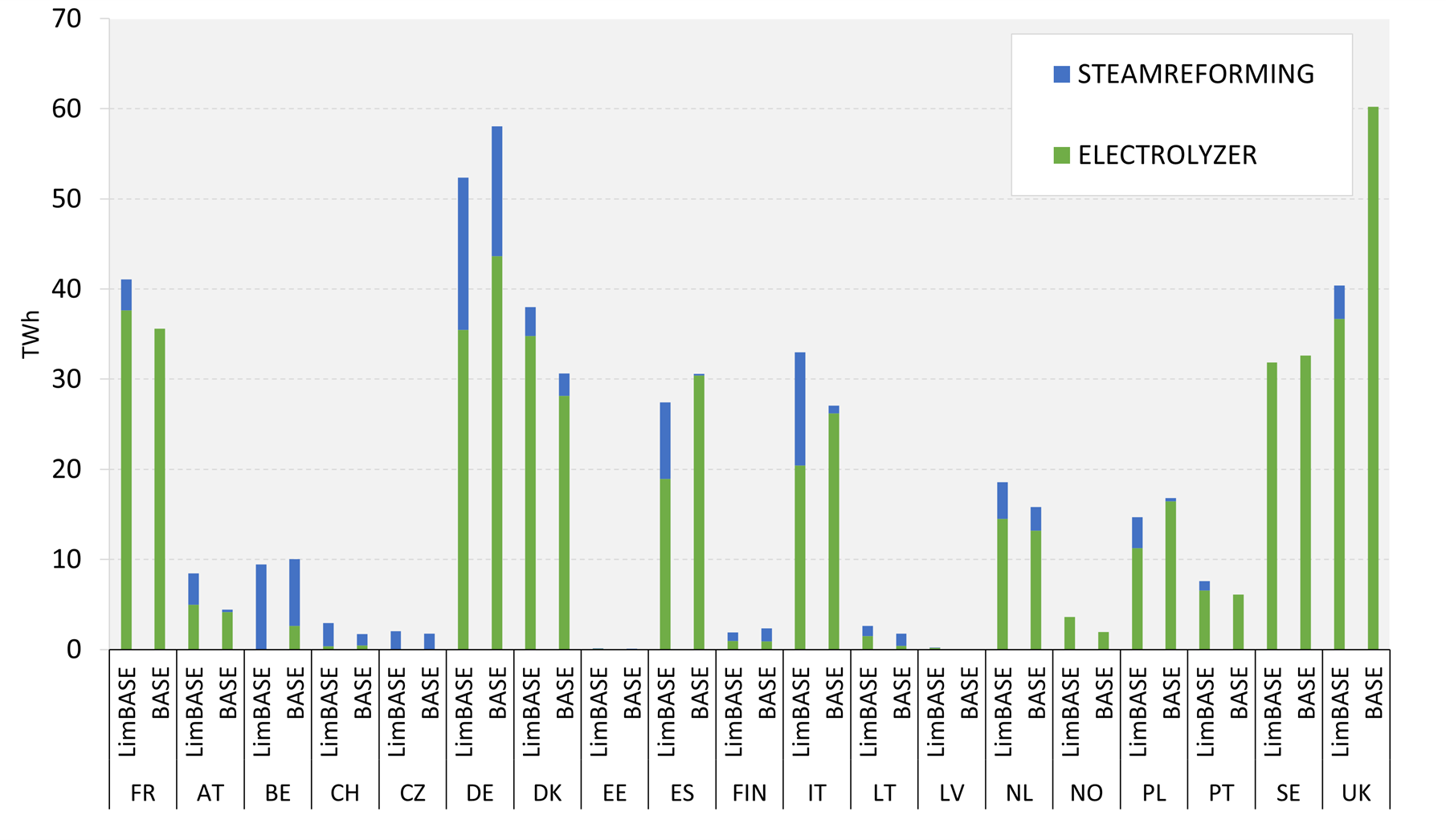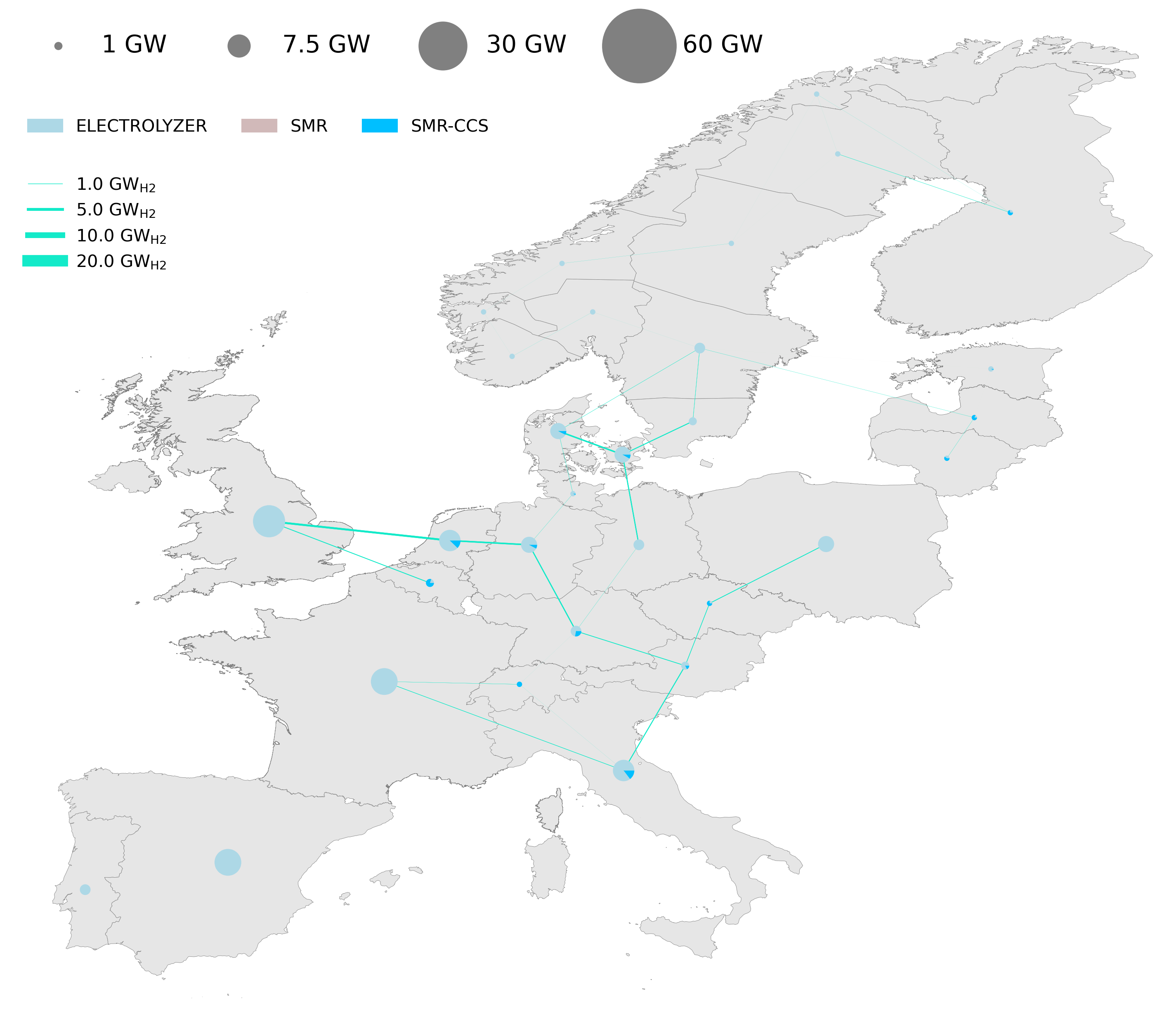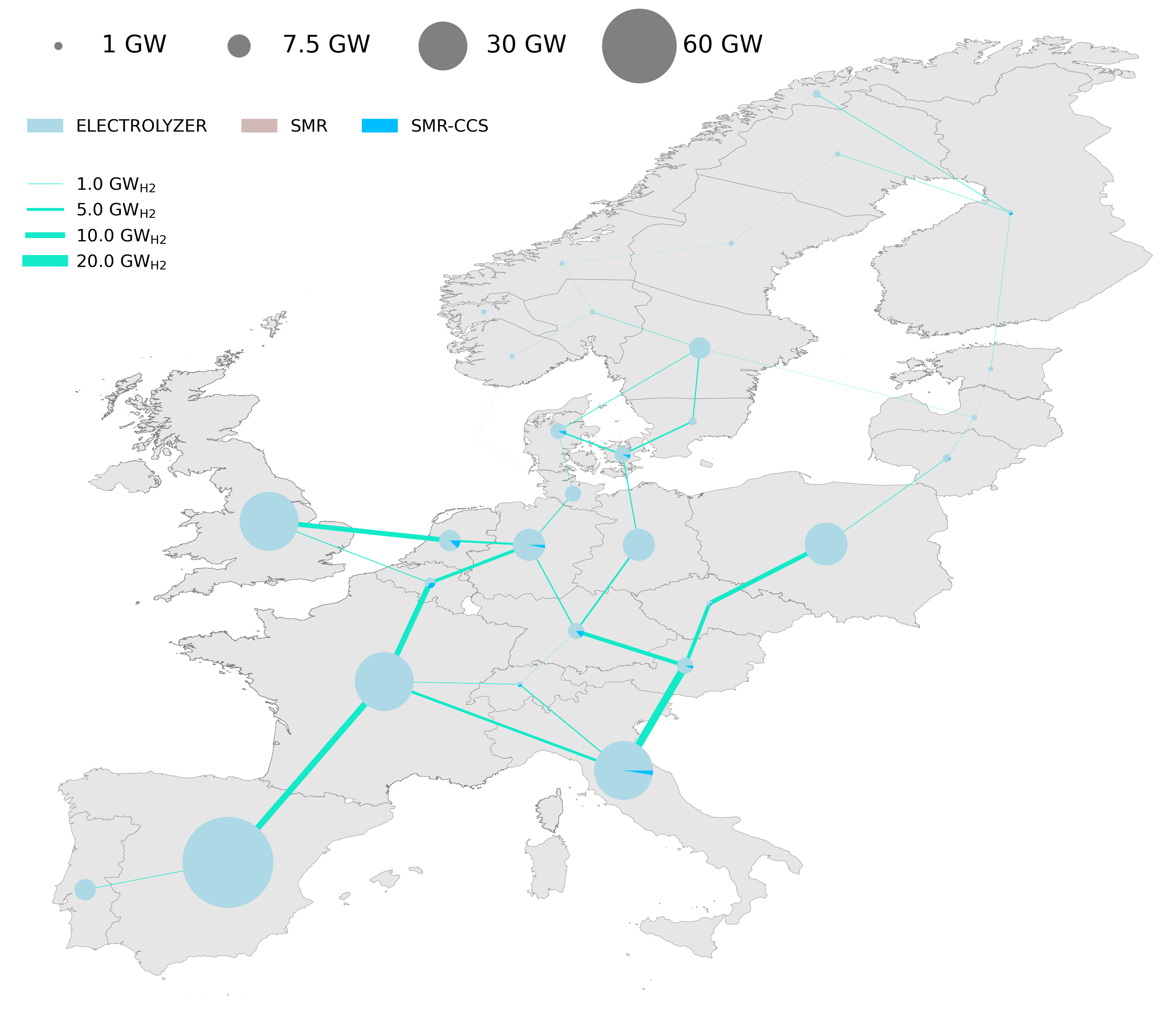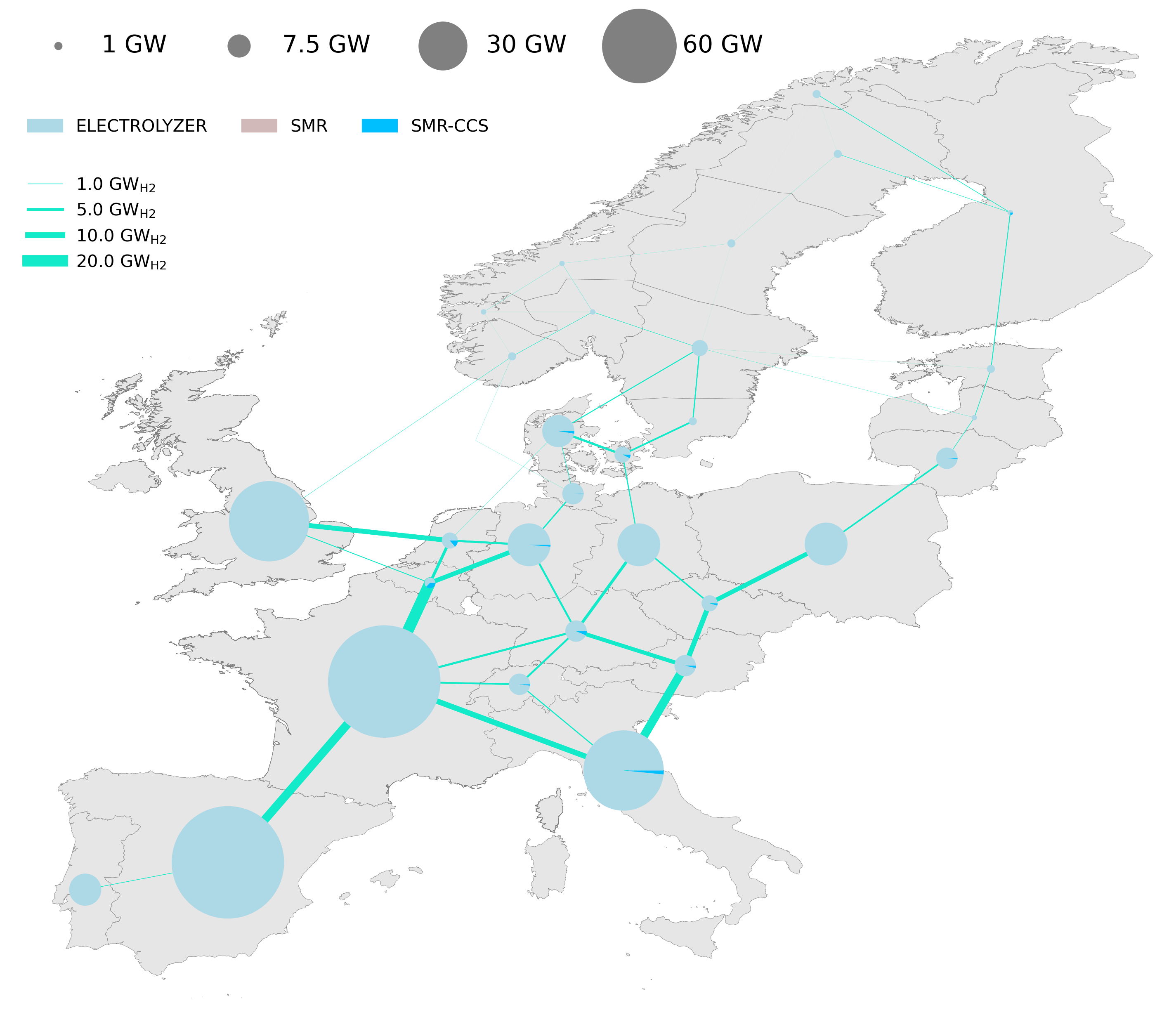Hydrogen Production in a European Energy System Perspective

Back
Introduction
Hydrogen is expected to become a key player in facilitating the green energy system, in particular, in decarbonising the hard-to-abate sectors such as high-temperature industrial processes, peak power production, and long-haul transportation.
Objective
Therefore, the objective of this study is to shed light on arising questions related to where, when and under which conditions green hydrogen will be produced in a European context. The study will furthermore address the potential benefits of installing and converting towards a new hydrogen backbone grid infrastructure.
Methodology
The comprehensive energy system model, Balmorel, is used to identify the least-cost energy system configuration. Balmorel encompasses all main energy sectors and allows investigations of where and when to produce green hydrogen. The Balmorel modelling framework also allows blue and grey hydrogen (from natural gas) to be produced, as well as the possibility to import hydrogen from the surroundings, e.g. North Africa (i.e., Marocco and Tunisia) and Ukraine. Balmorel has also been extended to allow assessments of the opportunities for producing hydrogen onshore or offshore at energy hubs. Furthermore, based on an extensive database, Balmorel computes the potential value of implementing a hydrogen backbone grid infrastructure, including hydrogen pipelines and storage facilities.
Analysis
We analyze two different scenarios based on technological alternatives. Salt caverns are promising underground storage technologies, utilizing vast European geological potential. Additionally, salt caverns offer affordable subsurface storage with effective hydrogen buffer mechanisms. Despite having a large amount of storage capacity, salt caverns are only found in certain places. Denmark, the United Kingdom, Germany's North, West, and Central region, the Netherlands, Belgium, Spain, and France are among the nations that could invest in them. Their unique spatial allocation creates opportunities for future European hydrogen infrastructure and creates competition between European countries.
Steel tanks, an alternative method, are more expensive and could be used to store hydrogen. Here, we show findings derived from two distinct technological options. The first scenario is called, “Base”, which illustrates how the hydrogen infrastructure and transmission could look like if salt caverns can be invested in. However, the underground storage of hydrogen comes with limitations and challenges. Yet most European gas TSOs are still experimenting with salt caverns and are having difficulties either building new ones or reusing the ones that already exist. A second alternative scenario is formulated.
The ‘LIMBase’, does not consider the opportunity for cheap, seasonal underground storage in salt caverns and illustrates the importance of accelerating their deployment. In the long run (2050), irrespective of the caverns alternative, a southern European hydrogen corridor, mainly from Spain, France, and Italy, is created. The decreasing investment costs of solar utility PV and the high renewable potential availability, affected by the sector coupling (electricity and hydrogen) formulate the hydrogen corridors. At the same time, the United Kingdom, with high onshore wind potentials, create another hydrogen corridor to the main demand centers located in central Europe. Other countries, such as Denmark, although they become early exporters in 2030, fall behind since hydrogen production utilizing electricity from offshore wind is not competitive with the rest of renewable technologies. Lastly, the high CO2 taxation affects the deployment of conventional hydrogen technologies such as SMR (i.e., from natural gas - grey hydrogen) toward 2030, promoting CCS utilization for low-carbon hydrogen production.
The absence of cheap underground storage affects the hydrogen network expansion, trading flows, and production technologies investments. The developed hydrogen grid aims at connecting the production centers with the demand centers of Europe. Furthermore, it provides flexibility and balances the hydrogen demand picks. In the short term (i.e., 2030), countries with caverns balance their hydrogen demands while providing flexibility to other regions (see results).
Conclusion
We conclude that the European countries can supply the estimated hydrogen demand. Hydrogen from electrolysis will primarily outcompete grey and blue hydrogen from 2030 and onwards, but that depends on future price estimates and common hydrogen infrastructure, including large-scale salt caverns. However, European countries can be self-sufficient with electricity-based hydrogen. Finally, we find that the least-cost solution is a combination between cheap solar-PV and P2G. However, it depends on the land-availabilities, socio-economic acceptance, and scale-up of hydrogen production in the countries in the south of Europe. However, production from offshore wind might also create a hydrogen corridor from the North due to large offshore wind potentials.
 Figure 5: 2030, Hydrogen Production.
Figure 5: 2030, Hydrogen Production.
 Figure 6: 2050, Hydrogen Production.
Figure 6: 2050, Hydrogen Production.
Results
Furthermore, the underground storage acts as a seasonal buffer and helps decrease the renewable electricity curtailment by means of hydrogen. We show that an absence of salt caverns could force the European System to invest additional capacities in steam methane reforming with CCS (low carbon hydrogen) to recover flexibility and satisfy the upcoming demand. However, an increase in future natural gas prices could promote further electrolysis investments.
In 2050, the combination of salt caverns and vast renewable investment, provide an excellent coupled system, which can help in the long run to face out low-carbon hydrogen (from SMR with CCS) by promoting more electrolysis installations. Yet, low-carbon hydrogen is still present in the energy system, despite not being produced in vast quantities as in the “LimBase” scenario. The transmission grid for hydrogen is also impacted. In contrast to the alternative scenario, the salt caverns help diffuse the requirement for balancing hydrogen pick demands by expanding the hydrogen grid among all the main hydrogen corridors.
In the results it can be seen how the lack of a storage option compels the establishment of more extensive hydrogen grid lines between Spain, France, and central Europe to satisfy the gas demands and account for renewable variability, mainly from solar investments.
Scenario Overview
- With Caverns
- Without Caverns
- 2030
- 2040
- 2050
 H2 grid, 2030 - Technology scenario with salt caverns for H2 storing
H2 grid, 2030 - Technology scenario with salt caverns for H2 storing
 H2 grid, 2040 - Technology scenario with salt caverns for H2 storing
H2 grid, 2040 - Technology scenario with salt caverns for H2 storing
 H2 grid, 2050 - Technology scenario with salt caverns for H2 storing
H2 grid, 2050 - Technology scenario with salt caverns for H2 storing
- 2030
- 2040
- 2050
 H2 grid, 2030 - Technology scenario without salt caverns for H2 storing
H2 grid, 2030 - Technology scenario without salt caverns for H2 storing
 H2 grid, 2040 - Technology scenario without salt caverns for H2 storing
H2 grid, 2040 - Technology scenario without salt caverns for H2 storing
 H2 grid, 2050 - Technology scenario without salt caverns for H2 storing
H2 grid, 2050 - Technology scenario without salt caverns for H2 storing
References
[1] Hydrogen Production in a European Energy System Perspective – paper in progress – more information later
[2] Gea-Bermúdez, J. Bramstoft, R. Koivisto, M. Kitzing, L. Ramos, A. Going offshore or not: Where to generate hydrogen in future integrated energy systems? Energy Policy 174, (2023), [link]https://doi.org/10.1016/j.enpol.2022.113382
[3] Hydrogen Production in a European Energy System Perspective – paper in progress
[4] Gea-Bermúdez, J. Bramstoft, R. Koivisto, M. Kitzing, L. Ramos, A. Going offshore or not: Where to generate hydrogen in future integrated energy systems? Energy Policy 174, (2023), [link] https://doi.org/10.1016/j.enpol.2022.113382
[5] Sanchez, I.N.B., Jacobsen, H.K., 2020. Potentials for transborder green gas and hydrogen certificate markets. Technical Report, [link] https://superp2g.eu/potentials-for-transborder-green-gas-and-hydrogen-certificate-markets/
[6] Amirkhizi, T., Jacobsen, H.K., 2021. Report/Working paper prepared in WP7 of the SuperP2G project, [link] https://superp2g.wvgw-kunden.de/wp-content/uploads/2022/09/WP7_Gas_regulation_comparion_working_paper_Feb_2021_-_Final.pdf
[7] Munster, M., Moller Sneum, D., Bramstoft, R., Buhler, F., Elmegaard, B., Giannelos, S., Iliceto, A., 2020,. Sector coupling: concepts, state-of-the-art and perspectives, [link] https://orbit.dtu.dk/en/publications/sector-coupling-concepts-state-of-the-art-and-perspectives
[8] Perey, P., Mulder, M., Kwok, K.K., Spatial-economic analysis of low-carbon hydrogen supply to the European market, 2021, [link] https://superp2g.eu/wp-content/uploads/2023/02/spacial-economic-analysis-of-low-carbon-RUG-part-post7.pdf
Authors
Ioannis Kountouris | Rasmus Bramstoft | Marie Münster | Dogan Keles